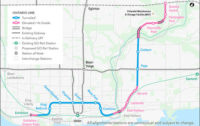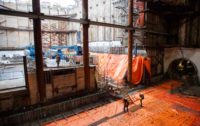Bidding for the nearly $8.5-billion Ontario Line subway in downtown Toronto will be split into three separate parts to open up competition as the Canadian province moves ahead on a public-private partnership project on the drawing board for decades.
Infrastructure Ontario and Metrolinx, the provincial transportation authority, have issued requests for qualifications for the first two of three planned P3 project packages under which the15.5-kilometer line will be built.
“This is by and far the largest and most significant project going on in the province,” says Bruce Matthews, CEO of Consulting Engineers of Ontario.
The new subway, which will run between Exhibition/Ontario Place and the Ontario Science Centre, will include as many as 15 stations and 17 connections to other subway and light rail systems.
Infrastructure Ontario said the decision to break up the project into three construction pieces is in response to a “commercial landscape that has changed dramatically and has been exacerbated by COVID-19.”
The virus impact has led to a “reduced appetite for major, multibillion-dollar Design-Build-Finance-Operate-Maintain single contract projects,” a spokesperson for the agency said. The subway P3 project is expected to draw interest from a wide range of Canadian and international engineering and construction giants.
One of the first two RFQs will cover supply of rolling stock and operations and maintenance for the new line; the other will be the design-build-finance contract for the Ontario Line’s southern portion, which includes construction of a 6-km tunnel.
The third RFQ, for the contract to build the northern half of the line, will go out “after the successful proponent for the southern civil package is identified,” Infrastructure Ontario and Metrolinx said in a press statement. A target date is early 2022, said one report. The package is set to include a 3-km tunnel.
Teams shortlisted by the RFQ will be asked to submit proposals this fall. The line is set to open by 2027.
Among likely candidates to vie for one of the Ontario Line's contracts are large Spanish, German and U.S. firms, noted Matti Siemiatycki, an associate professor in urban planning at the University of Toronto and an expert on P3 projects.
The international giants are likely to seek Canadian firms to partner with, including contractors Ellis Don, Aecon and Bombardier, Siemiatycki says. “This project is hugely significant and is by far the biggest transit project in Ontario since the building of the first subway lines.”
While the economic downturn and COVID-19 have reduced the capacity of major design-build firms to take on huge projects, there also has been growing industry caution about large and complicated P3s, he noted. A number of recent big transit projects have run into cost and budget issues, with SNC-Lavalin, a previously dominant bidder on P3 construction projects, exiting the sector last year to focus on consulting services.
“The project is so big ... that there wouldn’t be enough competition,” Siemiatycki says. “It would disqualify many bidders.”
Ontario also seeks funding from the federal government. "Investments in infrastructure projects, like the Ontario Line, will be essential for getting people back to work in greater Toronto," says Kinga Surma, regional associate minister of transportation. "To build projects of this magnitude, however, we need everyone at the table." The province wants a federal commitment "to paying ... at least 40% of the four nationally-significant subway projects," he says.
A team led by design firm HDR was selected in March as project technical adviser, along with Mott MacDonald, Stantec, Systra and Comtech, to provide planning, engineering, environmental review, design and construction oversight services.
"Moving forward with these procurement contracts signals the government remains committed to building much needed transit infrastructure to reduce congestion and contribute to the economic recovery," said Laurie Scott, Ontario minister of Infrastructure, in a statement.






Post a comment to this article
Report Abusive Comment